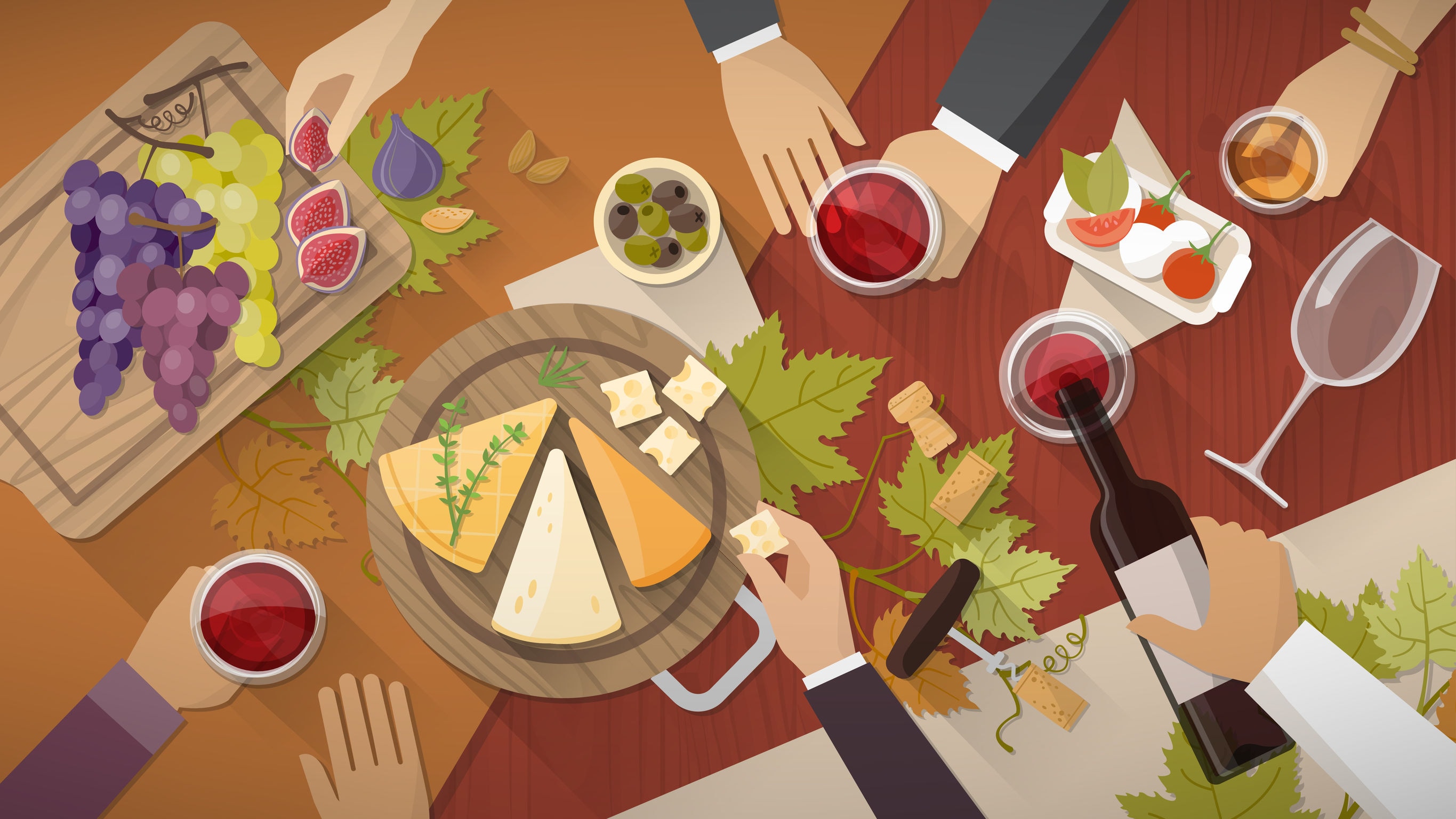Nowadays, the largest part of global wine production is industrial. Yeast strains are specially selected, bacteria is controlled, everything else is killed off. This results in brand wines with minimal vintage variation and a predetermined sensory profile. The same goes for bread and cheese.
Even in France, cheeses made with unpasteurized milk (really the best kind when it comes to complexity of flavor) comprise a mere seven percent of the total production.
That is why, with cheese as with wine, the most fun and deliciously surprising experiences come from tasting your way through smaller quality producers. The season, the quality of the primary products and “terroir” get more room to play.
Chemistry of wine and cheese matching
It is not only the biology in the production processes that lead to the most enjoyable gustatory experiences. When the cheese and wine meet on the palate, chemistry plays a big part.
We have a tradition of making cheese plates with everything from brie to blue cheese and cheddar, mixed, and then serving with a big red wine and some condiment, such as fig jam or honey.
If you like it, I won’t stop you! But if you take the time to really notice what happens in the mouth when an astringent red meets blue cheese or sweet condiments, you may discover that it is not an ideal match. Those rough tannins are to blame.
Tannins and casein
The tannins bind with fat, and even more so, with protein in the cheese. The more protein the cheese contains, the softer the wine gets. The sharp, rough tannins form conglomerates, tiny rounded “balls”, with the cheese protein, casein.
For this reason, a big or tannic red wine needs a well matured hard cheese such as parmesan, with a concentrated level of protein, to show well. The saltiness in the cheese will lift the fruit notes in the wine.
Mold spores from cheeses with an edible mold layer, such as blue cheeses, will instead react with the tannins to create bitter flavors. It’s not always a mis-match though, as some salty blue cheeses can be balanced by the sweet fruit flavors in a more supple, fruity red wine. A good reason to do some taste testing of your own!
The saltier or stronger the cheese, the greater the need for a touch of sweetness in the wine. Think port, like the classic port wine-stilton cheese combination. Cheeses with mild flavors, like brie or a triple cream, will be run over by the weight of a big red and can make the wine appear metallic and rough.
Better choice for white cheeses
So what to choose instead for these lighter cheeses? A white wine with lots of acidity and some richness of fruit (but of course, not tannins) will do quite well. The high acidity in the white wine will cut through the fattiness of creamy cheeses. Your palate feels fresh and ready for another bite.
Whether the wine is red or white, high acidity is always good in the combination with cheese, as most cheeses have high fat content. Fruitiness in the white wine is pleasant in moderation - just don’t let it be so prominent that it takes over.
A touch of oxidative nuttiness, like the one found in a fino sherry or Vin Jaune from Jura, give extra dimension to hard cheeses dominated by salinity and nuttiness.
The best cheese wine is: champagne!
My favorite wine for cheese is actually champagne, thanks to the high acidity and unobtrusive flavor profile. I match it with a plate of soft, creamy white mold cheeses such as brilliat savarin and chaource, a medium flavored washed rind cheese like langres and nutty, mild hard cheeses such as comté and gruyère or even parmesan.
No jams though, they will make the wine taste acidic, but I won’t say no to a good sourdough bread or some seed crackers.
The more pinot noir in the wine or the older the bottle, the more flavorful, ripe cheeses I pick, while a cheese plate with more weight on triple cream cheeses will be matched with a young blanc de blanc* champagne with low dosage**. Either will create heavenly experiences for which I thank monks, yeasts and bacteria.
*a champagne based only on white grapes, almost always pure chardonnay
** dosage is the sugar addition made to champagne after the second fermentation
Champagne and comté
Try a nutty champagne with an equally nutty hard cheese, such as comté or gruyère. If you are based in the USA, a Wisconsin “Roth Grand Cru” is another option. Bollinger “Special Cuvée” Brut (ca 60 USD) is a good option. The Champagne house sits on a large amount of oak barrels that impart lovely, toasty notes to the already beautifully creamy wine.
To be honest, Bollinger’s non vintage edition deserves a few years of cellaring before drinking, as that brings out the complexity and richness of the wine, but it is always an enjoyable bottle with cheese.
Amarone and parmesan
In contrast to most cheeses, parmesan is an excellent cheese with tannic and fruity, bold red wine. Try a 18+ month parmesan with Allegrini’s beautiful Amarone della Valpolicella Classico (ca 70 USD), one of the few Amarone’s still made in the classic style.
For a “weekday pairing”, grab a 12-month parmesan or a Grana Padano and a quality ripasso, or Allegrini’s Valpolicella Classico. In all of these pairings, the cheese will soften the wine’s tannins and bring out the layers of fruit.
Sauvignon Blanc and goat cheese
A New Zealand Sauvignon Blanc with an acidic backbone, or a quality Sancerre, complement creamy goat cheese. For a Kiwi sauv’ blanc with a bit more complexity than most in its price rance, try Greywacke’s vibrant Sauvignon Blanc (ca 20 USD) with an un-aged goat cheese/chévre. If you can find a Loire valley Crottin de Chavignol, that’s a delicious goat cheese for a pairing as well.





